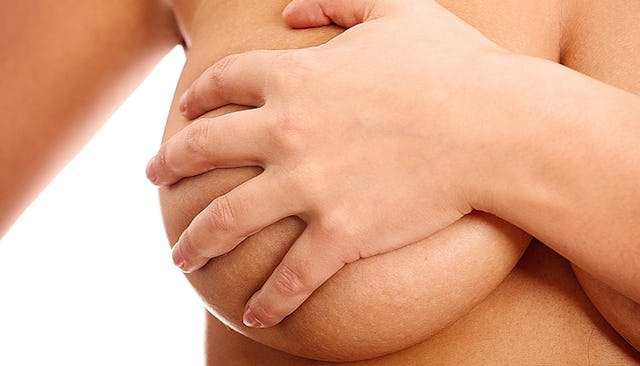Excuse Me, But Is That A Third Boob In My Armpit?

The first pregnancy is always the most exciting. That’s not to say that other pregnancies aren’t full of wonder, but the first one is full of all things new. Every change is a new experience and the unknown helps add to the thrill of it all.
I enjoyed that first pregnancy myself… that is, until i noticed a kiwi-sized lump growing in my armpit. The worst of scenarios raced through my mind. Did I have cancer? Was this a tumor? What the hell!?
RELATED: Are Dark Nipples A Sign Of Pregnancy? What This Bodily Change Could Mean
Sitting in the office of the ultrasound technician, I stared at the monitor trying to figure out what she was seeing on that little screen.
“What is it?”
“All I can see is breast tissue. I’ll send the results to your doctor.”
I felt a sense of relief, no tumor, just breast tissue…in my armpit. I had no idea why that would be, and my OB/GYN was actually of very little help in that department. I was told it was just breast tissue, breasts swell during pregnancy, and that it should go back to normal after giving birth. This was a great theory but, after looking around, no other pregnant women seemed to be walking around with a kiwi in one pit!
Finally, a lactation consultant friend of mine told me it could be an extra mammary gland. This was confirmed in the hospital after I gave birth to my first son. A second lactation consultant came in to check on the nursing situation and I blurted out, “I think I have a third boob.” In the tradition of lactation consultants getting all up in your boob business, she peeled back my hospital gown to examine the extra appendage.
This lady had all the good intel. Apparently, your milk lines run from your armpit all the way down your abdomen (think a cat or a dog with a litter of puppies). You can be born with extra mammary glands or extra nipples anywhere along your milk line and, unless you have a visible nipple, you may not know it’s even there until your breasts swell during pregnancy. The consultant then proceeded to tell me that there was a woman in the hospital the day before with eight boobs! (I can hear the collective gasps through the computer.) I suddenly felt pretty happy just to have the extra ONE. She then continued by saying that it would go away after nursing and that, because there was no visible nipple, it would dry up and shrink back to its former undetectable size.
But, here’s where she got it wrong: My milk finally came in for my first born, and while I was nursing him, I asked my husband if he’d turn up the air conditioning because I felt like I was sweating profusely. It was then that I looked down to see that no, I wasn’t sweating, but what I thought had been the tiniest of brown freckles was instead a nipple that was currently dripping milk down into a puddle on my shirt. Yep, sign me up for the circus, people! Not only do I have a third boob, but it lactates. Lac. Tates.
I had to nurse with a towel in my armpit, and while most nursing moms got to walk around with just absorbent breast pads in their bras, I got to do that and wear a huge band-aid on my armpit. Just so you’re all aware here, my son was born in June. Tank top weather. It was fabulous.
Between baby one and two, I had the boob surgically removed. There’s still breast tissue in there and with each pregnancy, it swells up to say hello, but at least there isn’t a nipple. I’m fine with the third boob thing, just not the wet clothing every time I need to nurse or hear a crying baby.
So, there you have it. I think the third boob can give everyone a brighter outlook on life and on their after-baby bodies. Your stomach may look like a venetian blind from the stretch marks you earned, or you may have skin that now somehow resembles an elephant’s trunk, but still, looking in the mirror at yourself you can always say, “at least it doesn’t lactate!”
So, here’s to you, third boob. Thanks for making most of the world feel a bit better about themselves… and for giving me a great story to tell. Cheers!
Related post: 4 Truths About Our Post-Baby Bodies
This article was originally published on